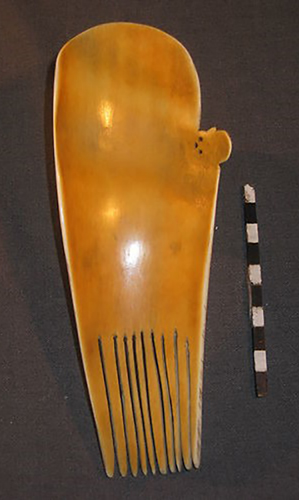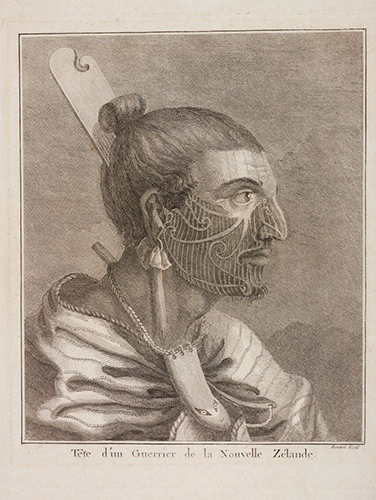However, the comb was dubious. The carving was not correct. The material had no grain. Whale bone has grain. Sperm-whale bone also has some grain. Although I did not record the exact measurements, the comb’s size indicated that it could have only come from the ivory tooth of an elephant. A whale tooth couldn’t possibly have been that big.
Here is the front and the back of this fake comb.
The back showed that the coloration of the sides was not congruent with the potential age it was supposed to be. The spikes were too uneven. Also, it did not have a single nick on the edge.


Here is a real one: the front and back of a 19th Century whale-bone Heru comb from North Island, New Zealand, which is in the collection of the Museum of New Zealand. It is 65 mm wide and 165mm long. The carver is unknown.


This is a picture of how it was worn by a warrior. The picture also comes from the Museum of New Zealand. In Māori culture, men wore their hair long with a top knot. The Heru was inserted behind the top knot. These combs only decorated the heads of top-ranking men. They were a symbol of mana, or status and prestige.

There is a Māori myth surrounding Heru combs. In 1200, Rua-tupu, the second son of Chief Uenuku, wore a Heru without permission. These combs could only be worn by the elder sons. His father belittled him. To get revenge, Rua-tupu took children of tribal noblemen into his canoe, traveled far into the ocean, and sank the boat. It is an incident in Maori history called “Te huri-pure-i-ata.” His older brother, Kahutia-te-rangi survived with the help of a whale, and his name changed to Paikea, or whale rider. The myth says Paikea had the help of the goddess Moa-kura-manu.
Heru combs like these depict Kahutia-te-rangi, or Paikea (the small carving on the left) riding the whale.
कंघी
With thanks to Mark Blackburn, Pierre Loos, Hugues Bienaymé, Charles Moreau, David Norden, Maureen Zarember, Jyrki Lammi, Guy Vdp, and Kajetan Fiedorowicz.
For more scholarly research, please examine

I will have to do some research on this story/myth the word Heru in ancient Egypt is the title of the ruler. Heru is the original native African name while Horus is the Greek adaptation. This type of research is called diffusionism and gets anthropologist in trouble with the mainstream. The natives of Hawaii also claim to be descended from Egyptian mariners. I will not elaborate here until I locate some references. I will end by saying to any detractors. The rest of the world did not rest quietly for Europeans to discover them. I will add one more point here Heru and Hero are etiologically connected. The Greek word came from the Egyptian name Heru or Horus. Herukahuti is the name of the avenger form of the deity.
Herukahuti became the Greek Hercules many of his labors are taken from the North African original.
Thanks for this post I have a new project for my students this summer as a result.
Robert
Thank you for your thoughts, Robert. We are thrilled to have you as an author.
I first researched the origin of Heru for the great comb by Patoromu Tamatea. His great-granddaughter wrote in. All of us just about died.
When you say, “The rest of the world did not rest quietly for Europeans to discover them,” I cannot tell you how strongly I agree with you.
Welcome!
After spending many hours researching the history behind a few tribal art pieces I own, I came to what I had always thought to be a Polynesian or Maori comb. I have not managed to find anything quite the same, so would love to pick your brains as your blog looked like you should be able to help. I would also love to know what Roberts findings were, as an amateur historian/archaeologist who’s very interested in alternative history.
yours,
Simon Lee